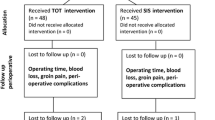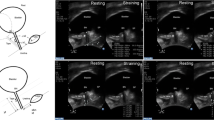Abstract
Introduction and hypothesis
Several studies have shown that immediate catheter removal following pelvic surgery is associated with several advantages. The aim of this case–control study is to compare immediate versus delayed catheter removal following mid-urethral sling surgery, to determine if indwelling catheterisation is necessary after this procedure. The secondary outcomes were subjective and objective cure rate after at least a 1-year follow-up.
Methods
Cases were defined as all the women who underwent a TVT Abbrevo for urodynamically proven stress incontinence. In every case the Foley catheter was removed by the surgeon at the end of the procedure. A voided volume >200 ml with a post-void residual of <100 ml, was considered a complete voiding trial. Patients who successfully completed the voiding trial and who did not develop any complications were discharged on the day of the surgery. We created a matched control cohort of women who underwent a TVT Abbrevo with delayed catheter removal (24 h after the procedure).
Results
Eighty women with immediate catheter removal were included. Each case was individually matched with one control. No statistically significant differences in voiding dysfunctions, postoperative re-catheterisation, postoperative urinary tract infection, early and late onset of overactive bladder (OAB) and vaginal erosion were found between the study groups. No significant differences in either subjective or objective outcome were observed.
Conclusions
Immediate catheter removal allows the patient with urodynamically proven stress incontinence without OAB symptoms, prolapse and voiding dysfunctions, to be admitted, treated and discharged on the same day in an outpatient setting, with a high subjective and objective outcomes after at least a 1-year follow-up.
Similar content being viewed by others
References
Waltregny D, de Leval J. New surgical technique for treatment of stress urinary incontinence TVT-ABBREVO from development to clinical experience. Surg Technol Int. 2012;22:149–57.
Bray R, Cartwright R, Digesu A, et al. A randomised controlled trial comparing immediate versus delayed catheter removal following vaginal prolapse surgery. Eur J Obstet Gynecol Reprod Biol. 2017;210:314–8.
El-Mazny A, El-Sharkawy M, Hassan A. A prospective randomized clinical trial comparing immediate versus delayed removal of urinary catheter following elective cesarean section. Eur J Obstet Gynecol Reprod Biol. 2014;181:111–4.
Hooton TM, Bradley SF, Cardenas DD, et al. Diagnosis, prevention, and treatment of catheter-associated urinary tract infection in adults: 2009 international clinical practice guidelines from the infectious diseases society of America. Clin Infect Dis. 2010;50(5):625–63.
Serati M, Salvatore S, Siesto G, et al. Urinary symptoms and urodynamic findings in women with pelvic organ prolapse: is there a correlation? Results of an artificial neural network analysis. Eur Urol. 2011;60:253–60.
Braga A, Caccia G, Sorice P, et al. Tension-free vaginal tape for treatment of pure urodynamic stress urinary incontinence: efficacy and adverse effects at 17-year follow-up. BJU Int. 2018;122(1):113–7.
Schafer W, Abrams P, Liao L, et al. Good urodynamic practices: uroflowmetry, filling cystometry, and pressure-flow studies. Neurourol Urodyn. 2002;21:261–74.
Haylen BT, de Ridder D, Freeman RM, et al. An International Urogynecological Association (IUGA)/International Continence Society (ICS) joint report on the terminology for female pelvic floor dysfunction. Int Urogynecol J. 2010;21:5–26.
Bump RC, Mattiasson A, Bo K, et al. The standardization of terminology of female pelvic organ prolapse and pelvic floor dysfunction. Am J Obstet Gynecol. 1996;175:10–7.
Coyne KS, Thompson CL, Lai JS, et al. An overactive bladder symptom and health-related quality of life short-form: validation of the OAB-q SF. Neurourol Urodyn. 2015;34(3):255–63.
Yalcin I, Bump RC. Validation of two global impression questionnaires for incontinence. Am J Obstet Gynecol. 2003;189:98–101.
Campeau L, Tu LM, Lemieux MC, et al. A multicenter, prospective, randomized clinical trial comparing tension-free vaginal tape surgery and no treatment for the management of stress urinary incontinence in elderly women. Neurourol Urodyn. 2007;26:990–4.
Abdel-Fattah M, Ramsay I, Pringle S, et al. Evaluation of transobturator tension-free vaginal tapes in management of women with recurrent stress urinary incontinence. Urology. 2011;77:1070–5.
Rosmini F, Ferrigno L. Ethical aspects of epidemiological research. Istisan reports 15/44. Epidemiology and Public Health. National Institute of Health 2384–8936 (Italy), 2015.
Tambyah PA, Maki DG. Catheter-associated urinary tract infection is rarely symptomatic: a prospective study of 1,497 catheterized patients. Arch Intern Med. 2000;160(5):678–82.
Onile TG, Kuti O, Orji EO, Ogunniyi SO. A prospective randomized clinical trial of urethral catheter removal following elective cesarean delivery. Int J Gynaecol Obstet. 2008;102(3):267–70.
Alessandri F, Mistrangelo E, Lijoi D, et al. A prospective, randomized trial comparing immediate versus delayed catheter removal following hysterectomy. Acta Obstet Gynecol. 2006;85:716–20.
Author information
Authors and Affiliations
Corresponding author
Ethics declarations
Conflicts of interest
None
Additional information
Publisher’s note
Springer Nature remains neutral with regard to jurisdictional claims in published maps and institutional affiliations.
Rights and permissions
About this article
Cite this article
Braga, A., Caccia, G., Regusci, L. et al. Mid-urethral sling in a day surgery setting: is it possible?. Int Urogynecol J 31, 817–821 (2020). https://doi.org/10.1007/s00192-019-04159-6
Received:
Accepted:
Published:
Issue Date:
DOI: https://doi.org/10.1007/s00192-019-04159-6




